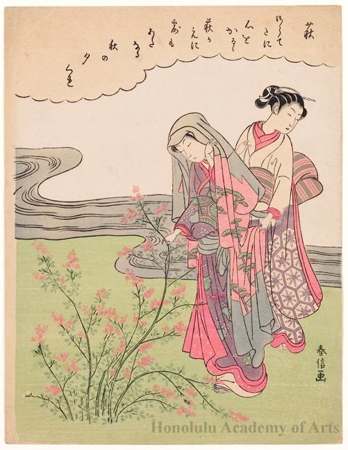
Title : Bush Clover
Artist : Suzuki Harunobu
Date : c. 1769
Details : More information...
Source :
Honolulu Museum of Art
Browse all 5471 prints...
Description : Within Japanese culture the seasons and their expression are well codified, with particular plants, birds, animals, and insects all signaling a change in season and in the feelings associated with particular times of the year. The bush clover depicted here is representative of autumn and the melancholy of the season as summer ends and winter approaches. The two figures, a high-class lady in a luxurious kimono and her attendant, who holds the lady's cape in her left hand as she glances away from the bush clover, or hagi, as it is known in Japanese, appear to be deep in thought. A sense of melancholy pervades the scene that is reinforced by the poem at the top of the print: To those delicate branches of hagi Which make one feel so concerned Even the dew looks disturbing On an autumn evening. (from Summer Evenings: Harunobu exhibition 5/30/06-) * * * * * * * ** * * * * * * * Within Japanese culture the seasons and their expression are well codified, with particular plants, birds, animals, and insects all signaling the changing seasons and the feelings associated with them. The bush clover depicted here represents autumn and the melancholy as summer ends and winter approaches. The main figure, a high-class lady in a luxurious kimono, appears to be deep in thought. Her attendant holds the lady’s cape in her left hand as she glances away from the bush clover, or hagi, as it is known in Japanese. A sense of melancholy pervades the scene, reinforced by the poem at the top of the print: “To those delicate branches of hagi Which make one feel so much concern Even the dews look disturbing On an autumn evening.” (from "VOGUE in Japan: Edo Fashion through Japanese prints" exhibition 07/30/08-)
Download ImageDo you have a similar woodblock print to sell?
Get in touch with us for a preliminary estimate and for information in selling your woodblock print.
GET IN TOUCH